Operations Team Keeps the Lasers Firing
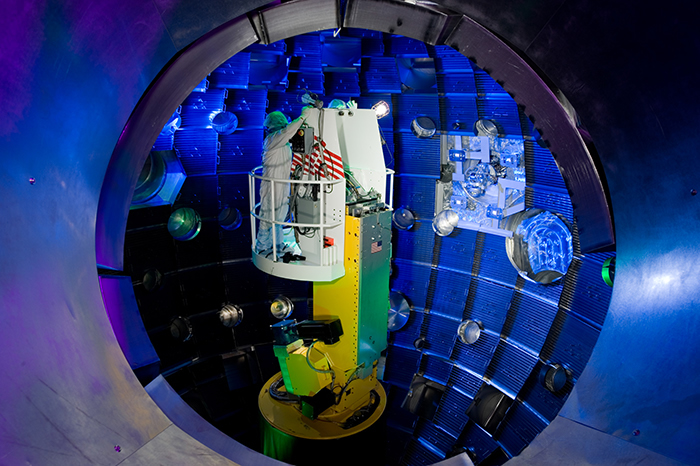 Target Area operators aboard the Target Chamber lift prepare for a regular Facility Maintenance and Reconfiguration period.
Target Area operators aboard the Target Chamber lift prepare for a regular Facility Maintenance and Reconfiguration period. It takes skill, dedication, and teamwork to keep a 192-beam laser facility the size and complexity of NIF operating safely, efficiently, and reliably. And the members of the NIF Operations Team have consistently shown that they are more than up to the task. Building on the lessons learned by overcoming challenges during the first few years of NIF operations, the team has continuously grown the laser’s energy, accuracy, and reproducibility to meet the requirements of ever-more-demanding experiments.
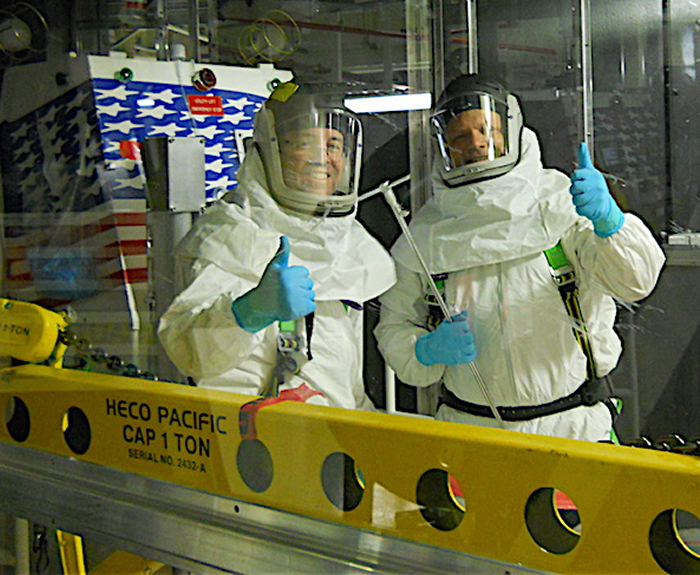 NIF Target Area workers Sam Ahrendes (left) and Mike Sullivan celebrate the successful installation of a new gate valve for the ARIANE gated x-ray detector. ARIANE (Active Readout in a Neutron Environment) measures x-ray output at yields up to about 1016 (one quadrillion) neutrons from Target Chamber Center.
NIF Target Area workers Sam Ahrendes (left) and Mike Sullivan celebrate the successful installation of a new gate valve for the ARIANE gated x-ray detector. ARIANE (Active Readout in a Neutron Environment) measures x-ray output at yields up to about 1016 (one quadrillion) neutrons from Target Chamber Center. The Operations Team works 24 hours a day, seven days a week, to keep the laser and its associated equipment running smoothly and operating at peak performance. Each NIF shot is an example of what planning and communication within and among teams with specialized areas of expertise can accomplish. The team’s innovations in operational efficiency, new technologies and equipment, and the carefully planned execution of tasks are some of the keys to NIF’s success during the past decade.
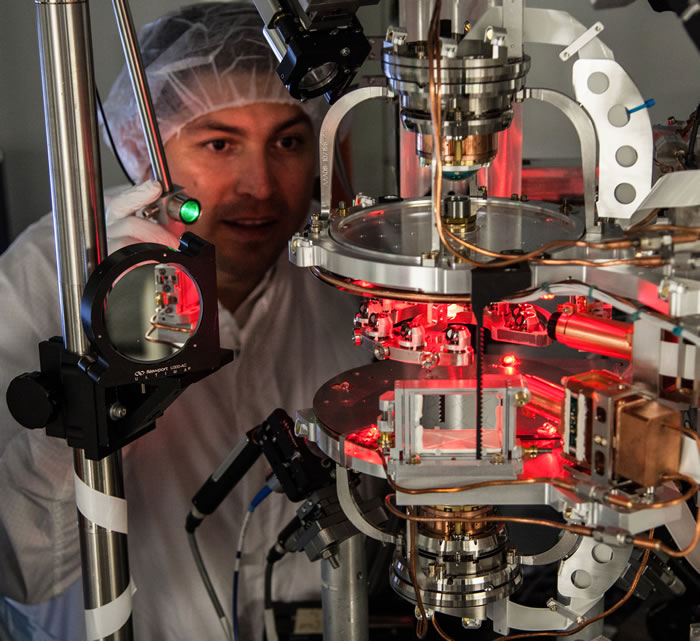 Target Alignment Sensor (TAS) Systems Manager Edwin Casco uses collimated light from an eye-safe lamp to verify alignment and clearances inside NIF’s TAS4 target alignment sensor. The TAS is a precision optical device inserted into the Target Chamber center by the target alignment sensor positioner (TASPos) to facilitate both beam and target alignment. The latest version, dubbed TAS4, is a significant enhancement over previous versions for one primary reason—it can operate in conjunction with NIF’s new Advanced Tracking Laser Alignment System (ATLAS). Credit: James Pryatel
Target Alignment Sensor (TAS) Systems Manager Edwin Casco uses collimated light from an eye-safe lamp to verify alignment and clearances inside NIF’s TAS4 target alignment sensor. The TAS is a precision optical device inserted into the Target Chamber center by the target alignment sensor positioner (TASPos) to facilitate both beam and target alignment. The latest version, dubbed TAS4, is a significant enhancement over previous versions for one primary reason—it can operate in conjunction with NIF’s new Advanced Tracking Laser Alignment System (ATLAS). Credit: James Pryatel NIF shot operations are conducted around the clock five days a week, from 6:30 a.m. Sunday to 6:30 a.m. the following Friday. Planning and scheduling a shot takes place weeks, even a month or more before the shot. On the day of a shot, the NIF Team executes hundreds of tasks to install the target and deploy the diagnostic equipment that ensures that the results of each experiment are captured and recorded.
“When the scientist comes back and tells you, ‘Hey, we got great results,’ or ‘Hey, you did a good job,’ it feels good being part of that. No matter what time it happens, or how it happens, we’re part of history—that’s how important the NIF facility is.”
—Alton Huey, Owl Shift injection laser and diagnostics technician
Technical teams have fabricated the target and readied the diagnostics weeks in advance, but both have to be installed the day of the shot. And the two “off” days, Friday and Saturday, are not truly off—they’re used to maintain the facility and the laser.
Since the introduction of tritium (a radioactive isotope of hydrogen) in 2010, NIF has become well-versed in managing a wide variety of hazards and hazardous materials. This includes the radiation fields created from more than a million-billion neutrons streaming from a single ignition experiment, to managing the hazards from tiny target components made of beryllium, a strong, light and hazardous metal that is relatively transparent to x-rays. As part of the National Nuclear security Administration’s Stockpile Stewardship Program, NIF has yielded valuable information in 18 experiments that use plutonium material smaller than a grain of sand. NIF is very environmentally friendly—releasing no plutonium or beryllium to the environment and capturing 99.9 percent of the tritium it uses.
Some 450 radiation workers keep NIF running around the clock and are trained in the safe handling of radioactive and hazardous materials. These workers are supported by the NIF Radiological Operations Team, which includes dedicated radiological control technicians and a team of safety professionals including the NIF Radiation Safety Officer, health physicists, and industrial hygienists.
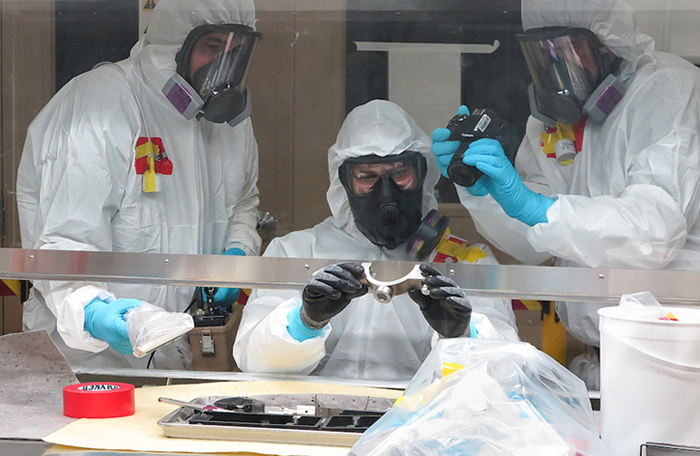 Radiation workers disassemble a plutonium diffraction target after an experiment.
Radiation workers disassemble a plutonium diffraction target after an experiment. Another key to NIF’s enviable dependability is the NIF Reliability, Availability, and Maintainability (RAM) Program, which promotes maintenance reliability and asset management both within NIF and across the Laboratory. The program received a 2016 Director’s Institutional Operational Excellence Award for streamlining maintenance efforts by evaluating maintenance tasks for applicability and effectiveness. As a result, preventive and reactive maintenance performed by the NIF Facilities and Infrastructure Systems Team has been substantially reduced; equipment lifetimes are increasing; and millions of dollars in avoided downtime and unnecessary maintenance have been saved.
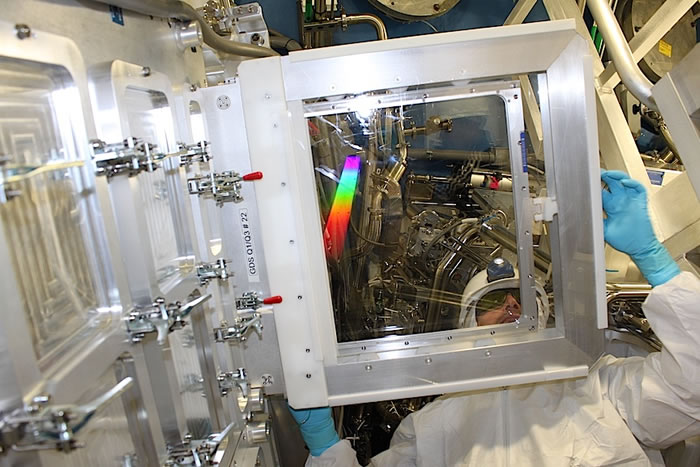 Target Area Coordinator Kevin Hood replaces a grating debris shield (GDS) in a NIF final optics assembly. The GDSs protect the other final optics from target debris and diffract about 0.1 percent of NIF’s ultraviolet light into an energy diagnostic system. More than 90 percent of damaged GDSs are repaired in the Optics Mitigation Facility and returned to service. Credit: Juan Soto
Target Area Coordinator Kevin Hood replaces a grating debris shield (GDS) in a NIF final optics assembly. The GDSs protect the other final optics from target debris and diffract about 0.1 percent of NIF’s ultraviolet light into an energy diagnostic system. More than 90 percent of damaged GDSs are repaired in the Optics Mitigation Facility and returned to service. Credit: Juan Soto 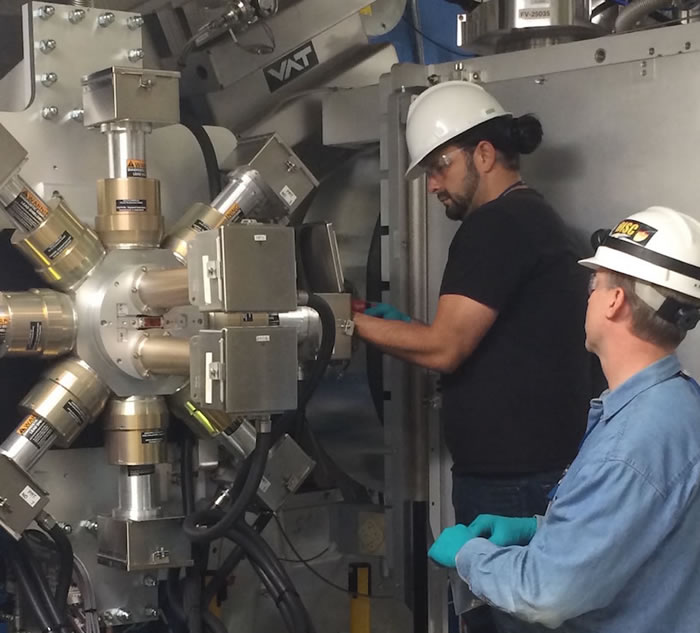 Target Area engineers Jorge Carrera (left) and Nathan Palmer replace the photomultipliers in the filter-fluorescer hard x-ray (FFLEX) diagnostic during a NIF facility maintenance and reconfiguration (FM&R) period.
Target Area engineers Jorge Carrera (left) and Nathan Palmer replace the photomultipliers in the filter-fluorescer hard x-ray (FFLEX) diagnostic during a NIF facility maintenance and reconfiguration (FM&R) period.  Power Conditioning System operators Dave Schwedler and Joe Foley inspect a bank of capacitors in the NIF Capacitor Bay. The NIF PCS is the world’s most energetic capacitor bank. Each of its 192 modules stores two megajoules of energy over a period of about 60 seconds in banks of high-voltage capacitors before releasing it to the flashlamps in a 400-microsecond burst.
Power Conditioning System operators Dave Schwedler and Joe Foley inspect a bank of capacitors in the NIF Capacitor Bay. The NIF PCS is the world’s most energetic capacitor bank. Each of its 192 modules stores two megajoules of energy over a period of about 60 seconds in banks of high-voltage capacitors before releasing it to the flashlamps in a 400-microsecond burst. 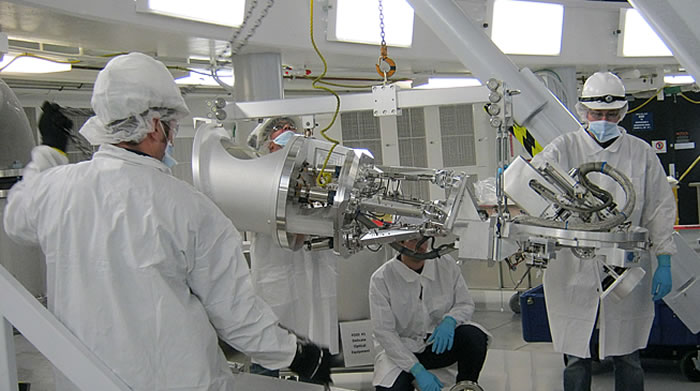 Mechanical engineer Keith Solberg and Eric Downing and Nick St. Hilaire of the NIF Transport & Handling Team remove the Final Optics Damage Inspection (FODI) instrument from its position in the NIF Target Bay to protect its camera and electronics from neutron radiation damage during a high-yield shot. Thanks to new lifting controls and devices and crew experience, this once complex operation is now routinely performed in a fraction of the time it once took.
Mechanical engineer Keith Solberg and Eric Downing and Nick St. Hilaire of the NIF Transport & Handling Team remove the Final Optics Damage Inspection (FODI) instrument from its position in the NIF Target Bay to protect its camera and electronics from neutron radiation damage during a high-yield shot. Thanks to new lifting controls and devices and crew experience, this once complex operation is now routinely performed in a fraction of the time it once took. More Information:
“NIF’s Night Owls: Where the Wild Things Are”
“Transport & Handling Teamwork: A Key to NIF Operations”
“Proactive Maintenance Saves NIF Shot Time and Money”Next Up: Control Systems



